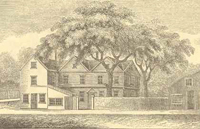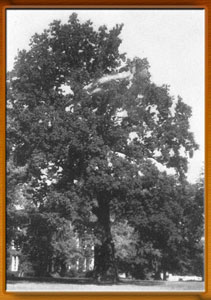TREE TALK
Originally published in Capital on July 3, 2008

Liberty Trees
Shaded the Sons of Liberty in 13 Colonies
The 4th of July holiday commemorates one of the most important moments, in fact one might argue the first, in the history of the United States. It marks the occasion when a group of dissatisfied and angry colonists decided they’d had enough of tyrannical rule and formally declared they were not part of the British Empire any more. A bold and precarious position to take given that England was the dominant power in the world at the time. Many of the original signers of the Declaration of Independence paid with their lives or died penniless as a result.
Some of the thinking and discourse that led up to this bold act was held under the spreading crown of an elm tree in Boston that came to be know as the liberty tree. Around 1765, a group calling themselves the Sons of Liberty would meet under the tree when a yellow ensign or flag was raised in the flagpole erected among the branches.
A group of folks hanging out around a tree was not considered a formal assembly so they were less likely to be harassed by the British. The Sons of Liberty was a popular group, there being quite a few people unhappy with the British, not only in Massachusetts but in the other thirteen colonies as well.
Soon every colony had a Liberty Tree and a group of
American patriots to assemble underneath. Maryland was no exception. A group
started to meet underneath a tree on a hill outside Annapolis on what is now St.
Johns College. This tree, the Maryland Liberty Tree as it became known, was a
Tulip-poplar that was a mature tree back then. In 1775, a rally was held under
the tree to commence the Annapolis tea party. Like the Boston Tea Party held a
couple of years earlier, this was a protest of taxes in general and in
particular on tea. No tea was thrown into the Annapolis harbor; however, a boat
full of tea was burned to the waterline. The protest was considered a success.
The Original Liberty Tree in Boston was cut down by British loyalists in late
August 1775 for spite and used for firewood by British troops. Served them right
- elm is miserable firewood, hard to split and doesn’t burn well. But the lack
of a tree didn't damp the spirits of the Sons of Liberty. These patriots being a
plucky lot, kept meeting at the tree now renamed the liberty stump, although
shade was probably scarcer.
The Liberty Trees in many of the other colonies suffered a similar fate. The
Liberty Tree in Charleston, SC a huge Southern Live oak (Quercus virginiana),
was also cut down and burned for firewood. Live oak does produce a better grade
of firewood though.
 The
Annapolis Liberty Tree survived the revolution, (probably because there was no
British occupation of Annapolis), the elements, and even gunpowder toting
vandals in the early 1800’s that tried to blow up the tree. It survived and
eventually this Liberty Tree became the National Champion Tulip–poplar. Over the
years it was cared for and nursed along, and in the early 20th century it was
treated by tree surgeons who scooped out the decay, applied disinfectants, and
filled it with a reported 55 tons of reinforced concrete. The concrete was
supposed to provide support, which is a practice not recommended by competent
professionals these days. (If anyone suggests that now they are just trying to
sell concrete.)
The
Annapolis Liberty Tree survived the revolution, (probably because there was no
British occupation of Annapolis), the elements, and even gunpowder toting
vandals in the early 1800’s that tried to blow up the tree. It survived and
eventually this Liberty Tree became the National Champion Tulip–poplar. Over the
years it was cared for and nursed along, and in the early 20th century it was
treated by tree surgeons who scooped out the decay, applied disinfectants, and
filled it with a reported 55 tons of reinforced concrete. The concrete was
supposed to provide support, which is a practice not recommended by competent
professionals these days. (If anyone suggests that now they are just trying to
sell concrete.)
But, like all trees father time took its toll and the tree
was removed in 1999 after Hurricane Floyd knocked off a few branches and
revealed extensive decay. The wood was put to use though. Musical instruments
such as flutes and guitars were made as well as writing instruments. Trees are
silent witnesses to historical events and, as in the case of the Liberty trees,
are sometimes part of the history.
Questions and comments can be directed to
ForestGreenway@comcast.net
Bud Reaves writes Tree Talk for the Anne Arundel County Forest Conservancy
District Board.
Photo of Liberty Tree on St. Johns College
Campus
by Fred W. Besley, Maryland's first State Forester, as found in
Big Tree Champions of Maryland: A Record of the Largest Trees of the Principal
Species, printed in 1956,
"TREE TALK" ArchivesAdditional Forestry-Related Links
Champion Trees of Anne Arundel County
Big Tree Champions of Maryland
Native Plants for Anne Arundel County
Planting and Care of Your Trees
TREE-MENDOUS MARYLAND
Invasive Species